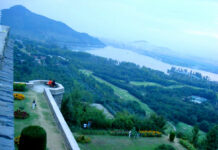Freak weather is one of the many identities of hill stations especially Kashmir. But for many years it is now clear the weather cycles are changing. An abnormally high temperature in March followed by frequent rains even by June are indicators of a larger reality that Kashmir is experiencing the effects of global climate change.
After many days of raining Kashmir was about to witness a flood, last week. There were many casualties. Frequent doses of hailstorm dented the possibility of a good crop, especially for apple in parts of south and north Kashmir. Cherry and strawberry crops suffered massive damage.
We need to accept that the climate change is a reality and there is a dire need to keep it in mind while drafting policy. There is an urgent requirement of sensitizing the people towards the changes they might need to bring in their lifestyle or livelihoods. The entire policy making has to be given a particular direction regardless of whether we are constructing a road, a building or a coal fired power plant.
Long term effects aside, there are immediate concerns too. Had there been rains for one more day last week, Srinagar would have inundated. We are not talking about overflowing drains or water logged streets but a complete flood. The water levels in the valley’s rivers was rising dangerously.
Well around a century back the autocrats thought it proper to set up a flood channel to save Srinagar from vagaries of the weather. The elected representative haves followed up, by making it shallow and unreliable.
A drizzle makes life hell in select areas of the city. Given the absence of planning and the development of haphazard colonies, draining the water logged lanes is a heady task. It takes time for official agencies to pump it out into the Jhelum that incidentally is the only draining system available with us. For all these years the engineers could never consider elevation of the stretches of the Srinagar-Jammu highway that submerge.
Srinagar is expanding so are most of the peripheral towns. Residents, soldiers, tourists and other floating populations are jointly straining the resource base. Land is under intense pressures so are the forests. These fundamental issues must be kept in mind by the policy makers while deciding the future course so that the growth is not washed away.









